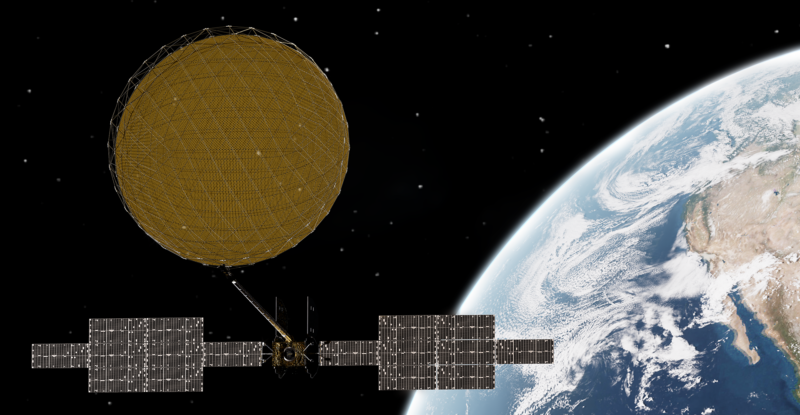HAMBURG — Prioritizing capacity for higher margin mobility customers, Viasat is looking to “focus on aviation” with the 5% to 10% of throughput it expects to glean from the ViaSat-3 F1 Americas Ka-band satellite that suffered an impairment, vice president commercial mobility Don Buchman revealed to RGN at the Aircraft Interiors Expo in Hamburg.
The Carlsbad, California-based satellite operator and ISP, which is powering broadband cabin connectivity on 3,500-plus aircraft, is also in the home stretch to having an interoperable aero terminal that will enable airlines to tap into both Viasat’s high-capacity satellites and the Global Xpress (GX) fleet it acquired with the Inmarsat buy. To that end, a Dual-Modem Modman is now in play for Viasat’s IFC system.
Tapping into VS3-F1 throughput
Noting that the original mission for the VS3-F1 satellite was “pretty broad” including directing high-density capacity at US-based residential users, plus aviation and maritime clients – and that the satellite was to provide a footprint covering “a third of the earth” with aviation and maritime “going to the far reaches” – Buchman said:
So, with the impairment we can’t do all those missions now. So now we’re probably going to serve the aviation mission very specifically. So, we’re looking at that … we’re still expecting to get anywhere from 5% to 10%. Kind of in the same realm but be focused on aviation.
So, it will be serving one of the missions: remember it was going to give us Pacific, so Hawaii is definitely one of the routes, the mainland of Hawaii …
We still have a lot of narrowbodies that fly today over Hawaii. So that’s a really good mission, you know, to use that resource to be able to serve that ahead of the next satellites coming online giving us the full Pacific.
As highlighted during Viasat’s recent earnings call, management expects VS3-F1 to enter revenue generating service ‘mid-calendar year 2024’.
Duel-Modem Modman in play
Coming on the backend of its integration with Inmarsat, Viasat is also adopting a Dual-Modem Modman to accommodate interoperability with GX. Here’s how Buchman describes the firm’s next-gen IFC upgrade path, both cabin-side and in the bay.
We’ve been upgrading our cabin, our kit. So, we’re already putting in our next-gen, what we call our cabin side. So that’s the wireless access points that get to the next generation ax (Wi-Fi 6). Remember we did our [802.11]ac Wave 2 WAPs back in 2015. It really worked well for us. We’ve gotten 10-plus years, still selling them.
Our nextgen server and WAPs are now coming out and [will] be cutting into linefit and retrofits this year.
And then now, after that, is our modem. So, the modem was a Viasat-specific modem prior. Now we’re going to cut in with what we’re calling a Dual-Modem Modman as well.
So, the Dual-Modem Modman is basically like it sounds, two modems and it’s a software-defined radio which is Viasat-developed technology … There’s basically something that the modem itself can have, different waveforms sitting on it. It can interoperate with many different … waveforms, that’s different infrastructures. And it’ll be able to host a third-party secondary modem. So, we’d be able to put in the legacy Inmarsat satellites such that we wouldn’t have to change out any of the GX networks, put in a card that would be compatible with that Dual Modman. Now any of our GM-40s [antennas] could interoperate between legacy GX and the legacy Viasat.
Viasat already taps capacity from undisclosed satellite partners, so this scheme meshes nicely with that paradigm. “Then we have the software-defined radio. We can basically do it via software or do it via a card, right, so we have all of our options. So that’s coming out,” said Buchman.
He continued, “[T]he great thing about the Dual-Modem Modman is you don’t have to change the outside. It’s fully compatible: the antenna, all of the RF on it is fully compatible with all of the Inmarsat, all the Viasat. This is our legacy GM-40 [antenna], the one that’s doing a million hours a month. That’s just a fantastic antenna, highest reliability in the industry. It’s just performing great. And a forward compatibility is going to give you everything we need.”
Wi-Fi integration with the seatback
Ten and a half years after being the first to support a free streaming class of service, on JetBlue, Viasat feels as if it predicted the IFC market fairly well. “We thought the market was going to go free. We thought streaming and everyone’s going to want to do what they do at home on their devices, so we thought ‘bringing my own content to my devices’ was big. So we’re seeing that trend and actually the third trend is now bringing all that to the seatback,” said Buchman. On the latter front, Delta is already working to integrate Wi-Fi into the seatback as part of the Delta Sync program, and Viasat is delivering live TV to the seatback and passengers’ devices across multiple airlines.
Edge-caching trials happening in homes
Interestingly, as edge-caching is having a moment in aviation, Viasat reckons it’s been doing it for years. “We don’t call it edge-caching. Basically, you know, it’s cooperating with the streaming partners, right, so we are able to basically bring content closer to the edge. Edge is still there, but we’ve been doing it in our homes.
“So we’ve had a whole product line running in our homes. We’re actually trialing it, we’re actually running it. Yes, we’ve had industry partners in the homes that have been doing it. A little bit under the radar, we’ve been doing it kind of in the background, but it’s not anything new. So we’ve been kind of leading in that area as well.”
The new bit would be to bring that functionality in-flight, he confirmed.
Hybrid LEO/GEO for aviation?
Having announced a hybrid GEO/LEO plan for maritime inclusive of Eutelsat OneWeb LEO capacity, in what some might call the ‘Starlink effect’, the obvious question is whether or not Viasat will adopt a similar architecture for aviation.
“The maritime market is perfect for it. You don’t have to cram everything into a single terminal. You don’t have the STC timeline,” noted the Viasat VP. As for doing it in aero, “maybe not in the same way. But yeah, we are always looking at that.”
Noting that there are some tradeoffs to using an electronically steered antenna for an IFC service that leads with GEO, Buchman said Viasat is exploring if it makes sense to support LEO with “a second smaller antenna. Or can I take advantage of that high reliability proven technology that does the best GEO and get the LEO benefits with it?”
JetWave X tail-mount solution coming to BizAv
Honeywell has traditionally provided a JetWave-branded gimbaled antenna-based terminal for GX IFC service in commercial aviation and a tail-mount solution in business aviation.
But the company is now touting a “JetWave X” solution in business aviation, saying that it will be the first Ka-band system “that can seamlessly connect to either the Inmarsat GX or ViaSat-3 network”.
A longtime reseller of aero service from both Viasat proper and Inmarsat, Honeywell reckons that JetWave X will tick a number of boxes for operators, including a simple upgrade path that will include incentives, according to Honeywell’s Forge connectivity sales manager Chris Bigwood on LinkedIn. Operators can retain existing Ka-band radomes and wiring.
Related Articles:
- Viasat sees entire Ka fleet supporting Royal Jordanian IFC in time
- SES to be prominent aero player with plan to buy Intelsat for $3.1b
- Viasat opens new International Business Headquarters in London
- Managed service pedigree drives Hughes IFC gains including at Airbus
- Viasat still determining NGSO ambition and its pertinence to IFC plan
- Viasat on securing basic interoperability with GX via minor tweaks
- Once an EAN adversary, Viasat cements commitment to hybrid network
Featured rendering credited to Viasat













